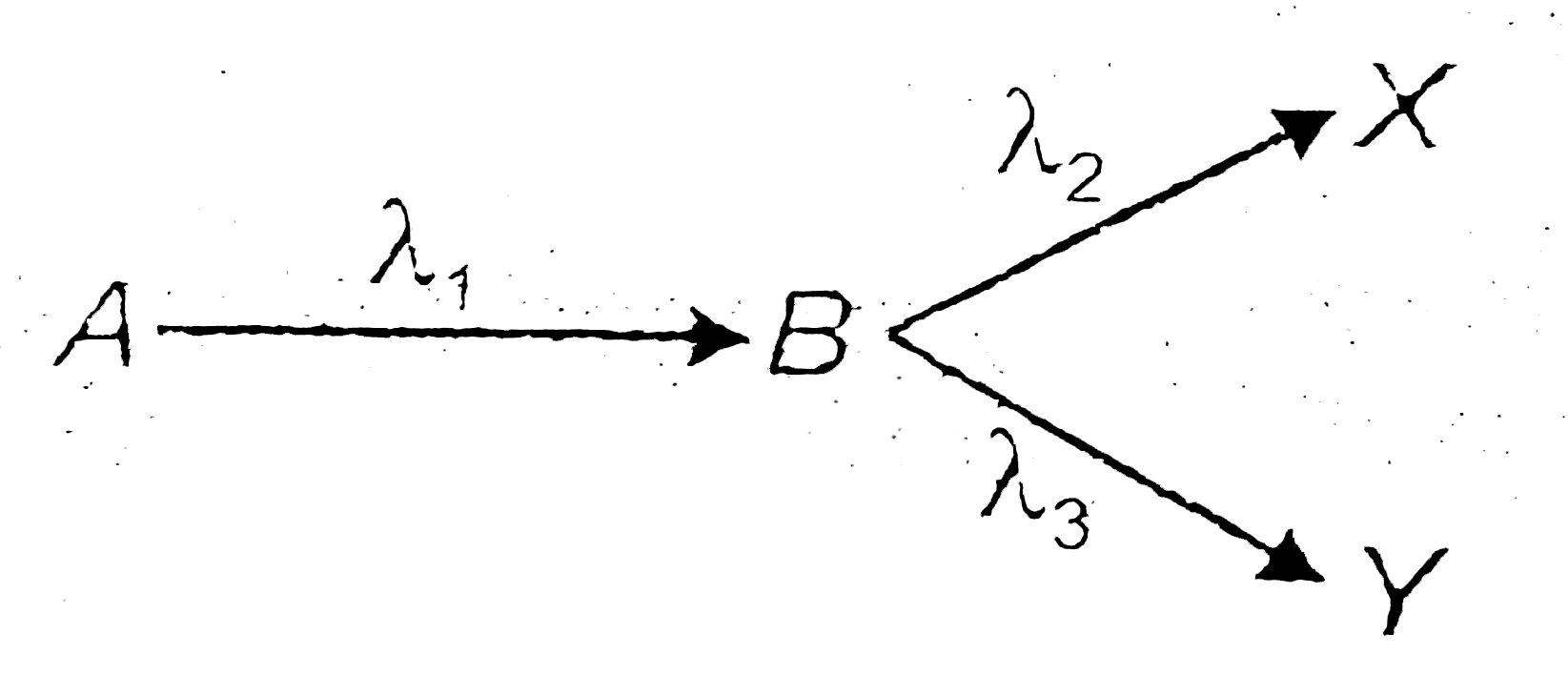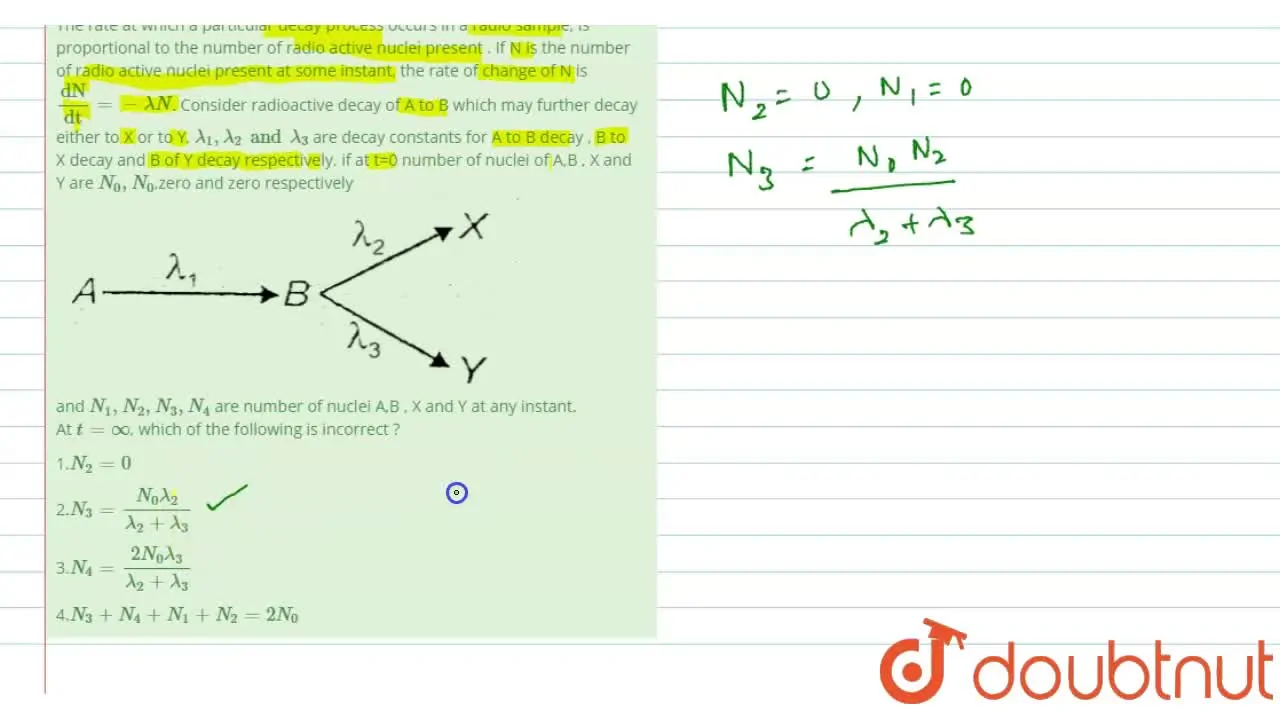The rate at which a particular decay process occurs in a radio sample, is proportional to the number of radio active nuclei present . If N is the number of radio active nuclei present at some instant, the rate of change of N is . Consider radioactive decay of A to B which may further decay either to X or to Y, are decay constants for A to B decay , B to X decay and B of Y decay respectively. if at t=0 number of nuclei of A,B , X and Y are ,zero and zero respectively

and are number of nuclei A,B , X and Y at any instant.
At , which of the following is incorrect ?
The correct Answer is:C
Step by step video & image solution for The rate at which a particular decay process occurs in a radio sample, is proportional to the number of radio active nuclei present . If N is the number of radio active nuclei present at some instant, the rate of change of N is "dN"/"dt"=-lambdaN. Consider radioactive decay of A to B which may further decay either to X or to Y, lambda_1, lambda_2 and lambda_3 are decay constants for A to B decay , B to X decay and B of Y decay respectively. if at t=0 number of nuclei of A,B , X and Y are N_0, N_0,zero and zero respectively and N_1 , N_2, N_3,N_4 are number of nuclei A,B , X and Y at any instant. At t=oo, which of the following is incorrect ? by Physics experts to help you in doubts & scoring excellent marks in Class 12 exams.
Related Playlists
- BOOK - AAKASH INSTITUTE ENGLISHCHAPTER - NUCLEIEXERCISE - Assignment Section E (Assertion-Reason )5videos
NUCLEI
- BOOK - AAKASH INSTITUTE ENGLISHCHAPTER - NUCLEIEXERCISE - Assignment Section F (Matrix-Match )3videos
NUCLEI
- BOOK - AAKASH INSTITUTE ENGLISHCHAPTER - NUCLEIEXERCISE - Assignment Section C Objective (More than one option are correct )10videos
NUCLEI
- BOOK - AAKASH INSTITUTE ENGLISHCHAPTER - MOVING CHARGES AND MAGNETISMEXERCISE - Assignment Section J (Aakash Challengers Questions)5videos
MOVING CHARGES AND MAGNETISM
- BOOK - AAKASH INSTITUTE ENGLISHCHAPTER - OSCILLATIONSEXERCISE - Assignment (Section D) (ASSERTION-REASON TYPE QUESTIONS)13videos
OSCILLATIONS
Similar Questions
The rate of biomass production by consumers is called :
View SolutionConsider radioactive decay of A to B with which further decays either to X or Y, λ1,λ2 and λ3 are decay constant for A to B decay, B to X decay and Bto Y decay respectively. At t=0, the number of nuclei of A,B,X and Y are N0,N0 zero and zero respectively.
N1,N2,N3 and N4 are the number of nuclei of A,B,X and Y at any instant t.

The net rate of accumulation of B at any instant isView SolutionConsider radioactive decay of A to B with which further decays either to X or Y, λ1,λ2 and λ3 are decay constant for A to B decay, B to X decay and Bto Y decay respectively. At t=0, the number of nuclei of A,B,X and Y are N0,N0 zero and zero respectively.
N1,N2,N3 and N4 are the number of nuclei of A,B,X and Y at any instant t.

The number of nuclei of B will first increase and then after a maximum value, it decreases forView SolutionThe unit of radioactivity decay rate is
View Solution78th of the active nuclei present in a radioactive sample has decayed in 8 s. The half-life of the sample is
View SolutionIn a sample of radioactive material, what percentage of the initial number of active nuclei will decay during one mean life ?
View SolutionNucleus A decays into B with a decay constant λ1 and B further decays into C with a decay constant λ2 . Initially, at t = 0, the number of nuclei of A and B were 3N0 and N0 respectively. If at t = t0 number of nuclei of B becomes constant and equal to 2N0, then
View SolutionDraw a graph showing the variation of decay rate with number of active nuclei.
View SolutionFour thousand active nuclei of a radioactive material are present at t=0. After 60 minutes 500 active nuclei are left in the sample. The decay constant of the sample is
View SolutionNucleus A decays to B with decay constant λ1 and B decays to C with decay constant λ2. Initially at t=0 number of nuclei of A and B are 2N0 and N0 respectively. At t=to, no. of nuclei of B is 3N02 and nuclei of B stop changing. Find t0?
View Solution


